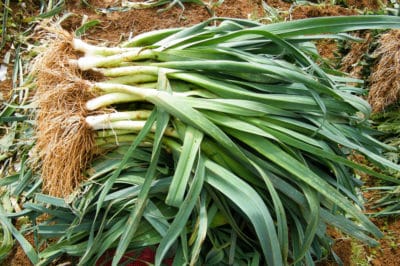What Is the Best Location for Planting Leeks?
Leeks require eight hours of full sunlight every day, so choose a location that gets direct sun. If you’re planting leeks in containers, you have more location options because you can move them to the sunniest area in your yard. They have an extended growing season because they are tolerant to frost.
What Are the Best Soil Conditions for Growing Leeks?
Not only do leeks need full sunlight, but they also require well-drained, fertile soil. For best results, your garden soil should have a pH of 6.2 to 6.8. You can test your soil with a home pH testing kit to determine if it’s suitable for leeks. If not, adding organic mulch to the soil can provide the fertility your soil needs for growing leeks. Using peas as companion plants to leeks adds nitrogen to the soil, which is beneficial to leeks.
When Is the Best Time to Plant Leek Seeds?
Since leeks take from 120 to 150 days to grow, so if you live in northern areas, start your seeds indoors in February or March. Normally, seeds take 2 to 3 weeks to germinate, in temperatures from 40°F (4.5°C) to 95°F (35°C). You should transplant your seedlings about 10 to 15 weeks after germination, and they are as thick as a pencil and 8-inches tall. The temperature should be at least 45°F (7°C) when you transplant your seedlings into your garden.
How to Harden Off Seedlings before Planting
When your seedlings are ready to transplant, harden them off to prepare them for chilly, springtime weather. If you have a cold frame, you can set out your leek seedlings about one week before planting time. If you don’t have a cold frame, set out the seedlings during the day, then bring them back inside at night for one week. You can also keep the seedling in a garage or shed at night, as long as they’re protected from cold temperatures at night.
How to Plant Leek Transplants
After hardening off your transplants, trim the roots to 1 inch. Dig trenches in rows of 1 to 3 feet apart. Plant the leek transplants from 2 to 6 inches apart. Arrange the leeks so the leaves grow in the spaces between rows. This will give the plants plenty of air circulation and light for growing, while conserving garden space.
An alternative planting method is to hill the leeks, planting them at ground level, then making a mound of compost around the plants. This method helps the leeks grow long, edible shafts.
How Much Water Do Leeks Need?
To prevent fungus growth on leek foliage, thoroughly water the soil around the plant every week. Too much watering can result in mold and fungal disease.
How to Control Insects that Infest Leeks?
The most common pests to invade leeks are onion thrips, bulb mites and onion maggots. Applying floating row covers, sealed on the edges can prevent these insects from invading your leeks.
What Are the Most Common Leek Diseases?
When planting leeks, watch for a few diseases that can attack your plants. In some cases, you can treat the diseases to prevent further damage, or use preventative measures to keep your leeks healthy.
Diseases that attack leeks include:
- White Rot
- Downy Mildew
- Basal Rot
- Botrytis Leaf Blight
Crop rotation and regular weeding helps reduce the occurrence of these diseases.
When Is the Best Time to Harvest Leeks?
Leeks are ready to pick when the stem is at least one-inch in diameter. If you planted a small leek variety, it can reach maturity when it’s one-half inch in diameter. The shaft should be white, firm and over 3 inches in length. The growth at the top of the shaft should be dark green. You can pull leeks from the ground with a gentle, twisting motion.
Since leeks are more tolerant to frost than onions, you can harvest them after a couple of frosts. The temperature can get as low as 20°F (-6°C) before harming the leeks. If you mound mulch around the leeks for protection, they’ll last until late fall.
